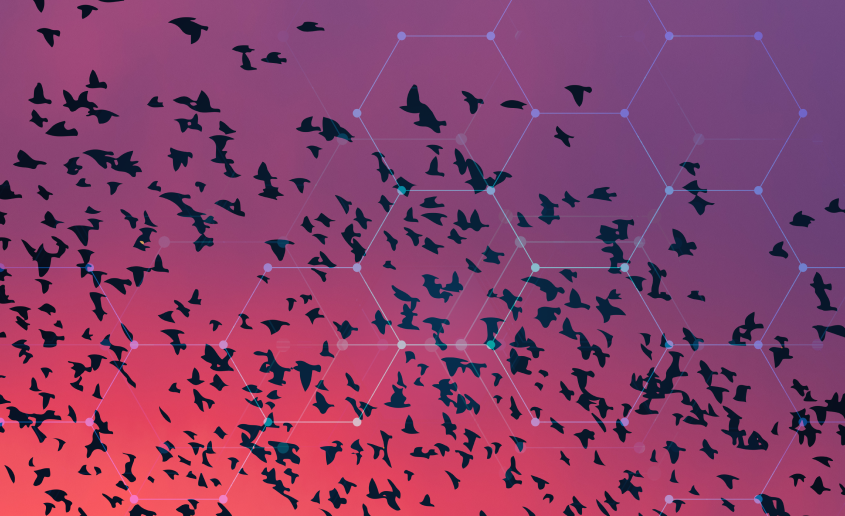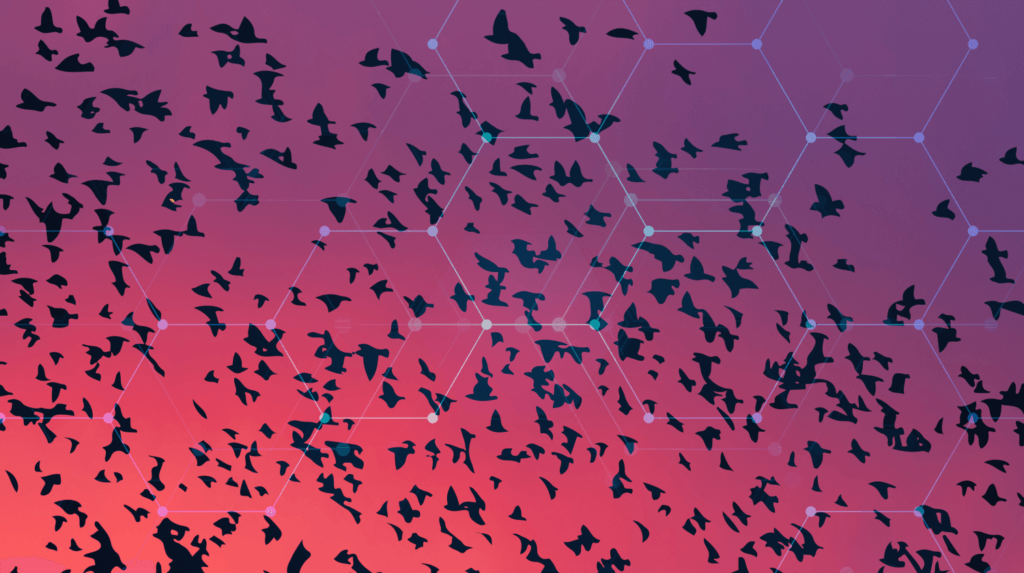“We live in a rainbow of chaos” – Paul Cezanne
The Free State Bookbindery, a red brick, 1930s era industrial building in Baltimore’s Hampden neighborhood, features a prominent chimney – a solitary square pillar that towers over the surrounding row houses. It is no longer connected to the long-disused heating system for the plant, but it has found another purpose.
In the late fall and early spring, the air above Hampden is filled with migrating chimney swifts. As dusk turns the sky cobalt, some thousands of the stubby, quick little birds will circle, swoop, and dive into the mouth of the chimney in a rush of feathers, to roost there for the night. This flocking behavior is beautiful to watch – a beauty which arises from a pattern that is both chaotic and organized, immediately apparent and impossible to grasp in its complexity.
The brain of a chimney swift is a wonderful mechanism, capable of guiding the birds in flight as they feed on flying insects and of navigating annually from North America across the Gulf of Mexico to the Amazon basin and back again. But it is not capable of directing an entire flock in its precise movements. Flocking and roosting behaviors are not determined by conscious, deliberate, and coordinated actions, but by patterns that emerge from basic rules which combine to guide the birds in flight as they converge on the chimney mouth.

The flocking behaviors of chimney swifts, the murmuration of starlings, the complex interactions of ants and bees, the patterns of weather, of ocean currents – these systems reflect the organizing power of chaos that underlies our every action, every interaction, every movement.
The universe we inhabit is a construct of chaos. We experience our world as solid, constant, and often unyielding, as you will find if you stub your toe on one of its infinite, and frequently inconvenient, protrusions. At our human scale we perceive light, sound, the electron repulsions that we interpret as touch, and we believe that these perceptions tell us the true nature of our environment.
But if we could look closely enough – below the threshold of human perception, beyond the microscopic scale, beyond the wavelengths of visible light, beyond particles whose existence can be inferred only by their effects, like dark planets, we might view the quantum foam on which our reality is built – a constantly fluctuating stratum where the substance of things is made and destroyed in a sea of probability.
Chaos Theory was founded on the idea that chaos is fundamental – that the unanticipated, unpredictable, random energy of chaos is a motivating force which drives innovation, imagination, and change. Great work does not come from the predictable action or the known solution, but from the idea that has not been conceived, the step that has not been taken. It requires trust in the unknown.
Years ago (decades, if I’m being honest) I worked for a small software company in Seattle, first as a visual designer and then as a software developer and finally as a product lead. In that role I enjoyed all the logic problems and intricacies of writing elegant code but the human factors involved in creating and delivering a product were alien to me. Our goals might have seemed well thought-out, documented in detail, and with a clear path for development and release, but there was always some intangible reason that we could not achieve our objectives in the way that I expected. The situation was very frustrating, but in my youth and inexperience I had no answers. Nor did I have much patience, which led to friction with the rest of the team.
One day a senior manager at the company sat me down in front of a whiteboard and drew a line on it. Turning to me he pointed to the board and said “This is how you want product development to work. You have a technical specification at one end and a release goal at the other end, and you want to follow a straight line from one point to the other.” I nodded vaguely, not really understanding where he was going. Of course that was what I wanted. Wasn’t that what we all should want?
Then he turned back to the board and drew a huge scribble all over the nice straight line. “This is how people work in the real world. There are always unknowns, conflicting priorities, unanticipated delays and just the general chaos of life, all combining to make the process anything but straight. The job of a leader is not to eliminate those things, but to accept them, manage them, and get the project done anyway – because there is no movement without chaos. It is inevitable. The opposite of chaos is not productivity, it is stasis.”

Chaos is inevitable.
I was confronted by a truth that went against everything that I thought I understood. I thought chaos was something to be stamped out with process, controlled by documents, managed with meetings and deadlines. And here was someone who was telling me not only to accept it, but to welcome it as an essential force.
I wish I could say that I had an epiphany at that moment, and that I instantly turned that lesson into becoming a better developer, a better manager, and a better person. But life is rarely that simple or straightforward. Which, of course, was the point, but it took me years to understand it, more years before I could begin to use that lesson in practice, and even longer before I began to realize that there is no point where the lesson ends. We keep learning, and reaching, and growing, and trying, and failing, and trying again, or everything stops.

The opposite of chaos is stasis.
Chaos is terrifying, in the way that the maelstrom is terrifying. We are not comfortable with the unknown and the unpredictable. We like our castles to be built on granite, not sand. We like our projects to follow rules and schedules and process – to be straight lines not random scribbles. And we should strive for these things, but we should also find joy in the unexpected event, the unforeseen change, the uncomfortable moment, because those things are evidence that we are moving, growing, and progressing, not merely standing still.
With Chaos Theory, we are building a team that embraces that lesson to produce great work – to create products and technology from vision and courage over mediocrity and stasis. We start every project with imagination, not merely because of the need to envision and discover, but because imagination is how the energy of chaos feeds creativity and movement.
Chaos is inescapable. We may contain it, as milk poured into coffee swirls in chaotic patterns but stays (we hope!) within the cup, or we may be immersed in it – as we contemplate the complexities of a Jackson Pollock painting, perhaps, or the rapidly-changing shapes of a starling murmuration – but it is always there, underneath any order that we may attempt to impose. We live, as Paul Cezanne said, in a rainbow of chaos. It is the fundamental creative force.
Categories:
Author Bio:
As a technologist, strategist, designer, and business leader, I have had the privilege of working with amazing people to create ground breaking products for over thirty years. Together we have built experiences that entertain, inform, educate, and amaze millions of people worldwide. I love all the things we have accomplished, but my favorite project is always going to be the next one. So…what’s next?


